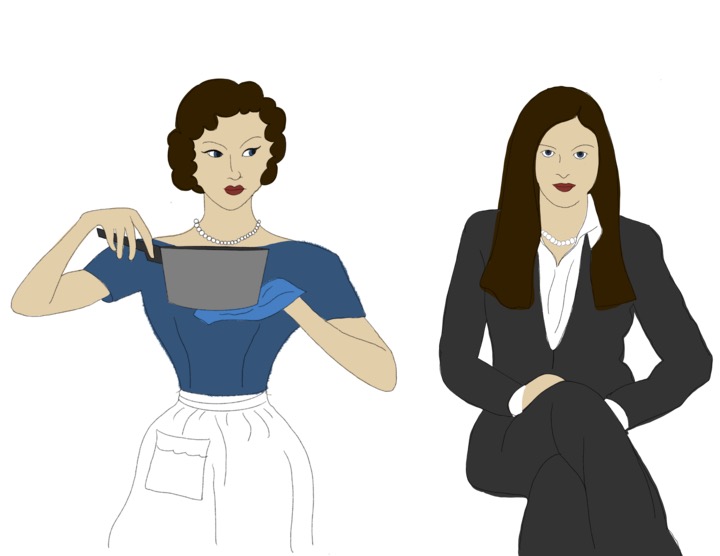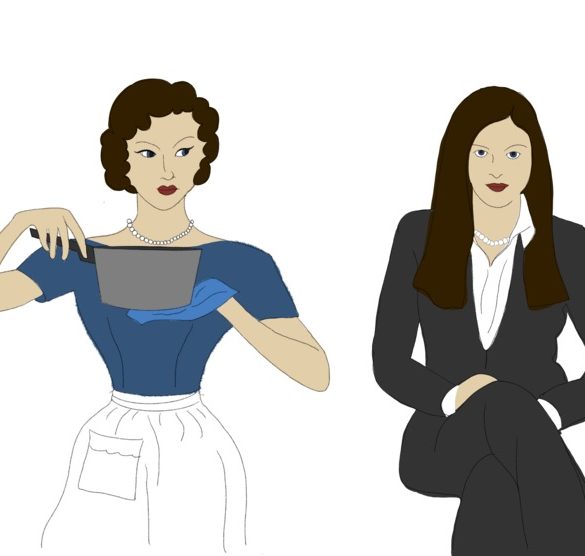A comparison of roles in the home and how they have changed over half a century of growth.
Popular television shows and movies, such as The Donna Reed Show and I Love Lucy, tell the story of traditional, affluent, white 1950s housewives in this way: After the husband leaves for a day of work, the dutiful housewife begins her daily tasks. Cleaning the house, shopping for essentials, hemming clothes, tending to the children, and ensuring that supper is warm and ready when her husband returns is a typical day for the housewife.
After dinner, the housewife clears the table and begins doing the dishes and cleaning the kitchen while the hard-working husband begins to retire for the evening after his long day of work in the city. As they both get into their bed after putting the children to sleep, the two prepare to wake up the next day to do the same things all over again.
This 1950s “traditional” household portrayed on-screen is dramatically different from the households that many of us are familiar with today. Homes all vary in their own ways, and most modern-day homes have strayed from the cookie-cutter 1950s image.
In the 1950s, conformity was key, according to Khan Academy. Along with the rising marriage rates, the number of American homeowners grew just as dramatically as it did quickly. According to U.S. History, a textbook written by P. Scott Corbett, homes could be purchased in cash for as little as $8,000, resulting in suburban areas growing by 46 percent during the decade. It was clear that the “American Dream” was in progress for many people at this time.
While life may have seemed near perfect to the average passerby, it may not have been as perfect as it seemed underneath the surface.
The Turning Point
During World War II, women flooded the workplace while men went to fight overseas. After the war ended, the women who weren’t displaced by the returning soldiers continued to contribute to the workforce, and their discontent for the status quo was growing day by day. Although the media and culture expected them to silently and respectfully give up their jobs and return to “normal” life, these women in the workforce made up one-third of the workforce at the time, according to Khan Academy.
Although the “traditional” household roles were extremely prominent in the 1950s, the decade also marked the turning point where things began to change.
Baby boomers, born between 1946 and 1964, were widely recognized as the largest generation. As the number of children rose, the need for caregivers rose alongside it. Yet despite the circumstances that created a breeding ground for social norms and gender roles, according to Khan Academy around 40 percent of women with younger children made the decision to stay in the workforce to provide for their families financially rather than staying home. According to a study conducted by the Bureau of Labor Statistics, the percentage of women in the workforce grew from 34 percent in 1950 to 60 percent in 2000. Having the ability to feel as if one was contributing to something larger was beginning to gain popularity.
People, especially women, began to realize the importance of self-satisfaction in their work lives and recognized that it would ultimately lead to being independent. In fact, according to the Bureau of Labor Statistics, an increasing number of women remained single, and women who did choose to marry during this time did so much later in life.
The change between these different lifestyles was a slow shift, and it even continues to change today.
The New Normal
Flash forward to the present day. While gender roles still exist in everyday life, they are a lot more fluid. People are encouraged to do whatever fulfills them in their work and in their pastimes, no matter how they identify. It seems as if society has come to the realization that household duties can be completed by anyone, regardless of gender.
Additionally, households today are not always made up of a female and male partnership. LGBTQ+ households are much more common now that there are laws that protect queer marriage and relationships. In the year 2019, the Census Bureau found that nearly one million households were composed of same-sex couples. Most same-sex couples were women rather than men, also according to the Census Bureau.
The Census Bureau also reports that same-sex married households are more likely to be in the workforce than opposite-gender households by just over four percent. Same-sex couples make nearly $10,000 more annual income than opposite-sex couples. However, same-sex male couples make nearly $36,000 more annual income than same-sex female couples.
For the past 15 years, the pay gap has remained moderately steady. But why does the gap still exist? Pew Research Center claims it may be due to factors such as previous work experience, education, or occupational segregation.
A 2020 Pew study found that women earned 84 percent of what men earned and that it would take an extra 42 days for women to make up for the gap. While the gap is still significantly large today, it is slowly closing in. In 1950, women made 59 to 64 cents for every dollar their male counterparts earned.
Gender Roles: Reversed or Eradicated?
Traditionally, women are recognized as staying home after having a child more often than men. Out of the more than 11 million parents in the United States that don’t work outside of the home, nearly one in five is a stay-at-home parent, according to Pew.
While income may not always be everything, it is still important. Stay-at-home parenting has become a “luxury” for some in recent years. Being able to afford to live on a single spouse’s salary is desired by some couples due to the costs of caring for a child. According to a study conducted by Zillow, higher income-earning households are more likely to have a stay-at-home parent than their lower-income counterparts.
Pew reports that the number of stay-at-home dads has risen from 4 percent to 7 percent in the past 30 years, while the number of stay-at-home moms remained steady, around 27 percent.
Because of these changes, Donna Reed and the 1950s housewife are no longer as confined as they were 70 years ago. Cooking, cleaning, and caring for children is now widely seen as a job that any gender is capable of. The roles we see within the home today include more than just a mom and a dad, or two kids and a white picket fence. Instead of fitting into the cookie-cutter mold, homes have started to transform into more inclusive and accepting spaces.
Sources: Khan Academy, United States Census Bureau, U.S. History, Khan Academy, Khan Academy, Bureau of Labor Statistics, Bureau of Labor Statistics, United States Census Bureau, United States Census Bureau, Pew Research Center, Pew Research Center, Infoplease, Pew Research Center, Zillow, Pew Research Center
Featured Image: Kami Geron




